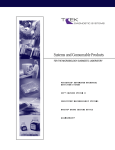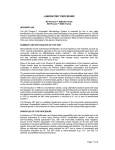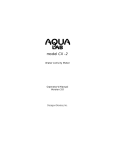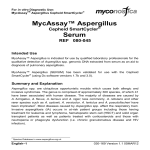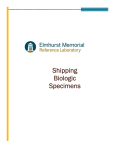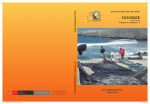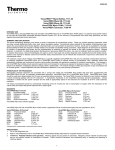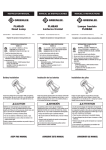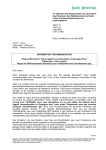Download SENSITITRE® YEASTONE® For in vitro
Transcript
SENSITITRE® YEASTONE® For in vitro Diagnostic Use For full plate information, including plate layout, QC information please refer to www.trekds.com/techinfo. The plate code and batch number will be required. INTENDED USE The Sensititre® susceptibility system is an in vitro diagnostic product for susceptibility testing of non-fastidious yeast including Candida species, Cryptococcus species, Aspergillus species and miscellaneous other rapid growing yeast species. It is a micro broth method that provides qualitative quantitative Minimum Inhibitory Concentration (MIC) results in a dried plate format. TREK Diagnostic Systems ® manufactured broth has only been validated with Sensititre Products. PRINCIPLES OF USE The Sensititre® yeast susceptibility test is a colorimetric microdilution test. Each plate is dosed with antifungal agents at appropriate dilutions, and a colorimetric indicator. Results are read manually by observing the lowest antifungal concentration showing inhibition of growth (as evidenced by no color change). PRECAUTIONS Results should be used as an aid to selecting the drug of choice for treatment Only personnel trained in susceptibility testing techniques should use the system Since living microorganisms used with this product can be infectious to the user, proper handling and disposal methods should be used. STORAGE AND SHELF LIFE The plates should be stored at room temperature (15-25°C) away from direct sunlight and direct heat. Each plate is packaged in foil with a silica gel desiccant. Do not use the plate or broth if past its expiration date, or the desiccant color is not blue or orange or the foil pouch is damaged. Inoculate the plate within 5 hours of removal from the pouch. PROCEDURE Materials Included: YeastOne® susceptibility plate Adhesive seal Materials Not Included [TREK Inc Product code]: Sensititre® demineralised water [T3339] Sensititre® yeast susceptibility inoculum broth [Y3462] Sensititre® doseheads (for use with AutoInoculator®/AIM®) [E3010] Sensititre® AutoInoculator®[V3010]/ Sensititre® AIM® [V3020] Sensititre® Vizion® [V2021] Sensititre® Nephelometer ® [V3011] 1 Manual Viewer [V4007] 0.5 McFarland turbidity standard [E1041] Bacteriological loop 20µl pipette Sterile inoculum reservoir 100ul pipettor and disposable tips Quality control strains Fungal growth medium agar plates e.g Sabauroud dextrose agar (SDA) Incubator 34-360C, non-CO2 Vortex mixer Current CLSI documents Aspergillus spp only Takashio or potato dextrose agar Cotton Swab Sterile saline with 0.05% Tween 20 Spectrophotometer SPECIMEN COLLECTION AND PREPARATION Specimens should be collected, transported, stored and then plated on to primary isolation medium to give isolated colonies using standard procedures. (1) SELECTION OF SUSCEPTIBILITY TEST BROTH Sensititre® approved broths are performance tested for use in Sensititre® susceptibility products. INOCULATION PROCEDURE (Candida and Cryptococcus spp.) Allow all broths to come up to room temperature before use. A final organism density of approximately 1.5 - 8 X 103 CFU/ml is recommended. 1. Pick several well-isolated colonies of >1mm diameter from a pure 24-hour culture of the Yeast isolate, and emulsify into sterile water. Vortex mix the suspension for 15 seconds, ensuring that the suspension is uniform. If clumping occurs, allow them to settle before adjusting the density. Adjust to a 0.5 McFarland standard visually or using a Sensititre® Nephelometer® 2. Transfer 20 l of the suspension into 11 ml of YeastOne® inoculum broth, to give an inoculum of 1.5 - 8 X 103 CFU/ml. Steps 1 and 2 should be completed in 15 minutes. 3. Transfer 100µl by either: a. Sensititre® AutoInoculator®/ Sensititre AIM®. Replace the tube cap with a Sensititre® single-use dosehead and inoculate the plate according to the AutoInoculator® /AIM® instructions. Remove the test tube dosehead combination from the AutoInoculator® /AIM® within 30 seconds of dosing a plate and store inverted in a rack or discard. b. Manual pipette. Pour the broth into a sterile seed trough and inoculate the plate using an appropriate pipette. Inoculate broth into a plate within 15 minutes. 4. A check of the colony count should be done by removing 10 l from the positive control well and plating onto Sabauroud dextrose agar (SDA). A correct inoculum will produce 10-80 colonies. 5. Cover all wells with the adhesive seal. Avoid creases as these can lead to skips. 2 INOCULATION PROCEDURE (Aspergillus spp.) (5-7, 22) Allow all broths to come up to room temperature before use. 1. Subculture from Sabouraud dextrose agar onto Tasashio or potato dextrose agar. Incubate for 7 days at 35° C to obtain adequate sporulation. 2. Collect conidia with a cotton swab and suspend in sterile saline with Tween. 3. Allow heavy particles to settle for 3 to 5 minutes. 4. Collect supernatant and mix with a vortex mixer. 5. Adjust turbidity of supernatant to 80 to 82% transmittance at 530nm measured with a spectrophotometer equivalent to an inoculum of 0.6 – 5 x 106 cfu/ml. Alternatively, adjust to a 0.5 McFarland Standard (22). 6. Add 100 l to 11ml of YeastOne® inoculum broth to give a final inoculum of 0.5-5 x 104 cfu/ml. 7. Transfer 100µl by either: a. Sensititre® AutoInoculator®/Sensititre® AIM® . Replace the tube cap with a Sensititre® single-use dosehead and inoculate the plate according to the AutoInoculator® /AIM® instructions. Remove the test tube dosehead combination from the AutoInoculator® /AIM® within 30 seconds of dosing a plate and store inverted in a rack or discard. b. Manual pipette. Pour the broth into a sterile seed trough and inoculate the plate using an appropriate pipette. Inoculate broth into a plate within 15 minutes. 8. A check of the colony count should be done by removing 10 l from the positive control well and plating onto Sabauroud dextrose agar (SDA). A correct inoculum will produce 50-500 colonies. 9. Cover all wells with the adhesive seal. Avoid creases as these can lead to skips. INCUBATION Minimally incubate the plates for 24-25 hours at 35° C in a non-CO2 incubator. Cryptococcus species should be incubated for 72 hours. Aspergillus species should be incubated for 48 to 72 hours. Incubation at temperatures over 35°C may affect the performance of these plates. Up to 3 plates can be stacked if not incubated in the ARIS®. READING TEST RESULTS Plates may be read visually under normal laboratory lighting using a manual mirror viewer or by using the Sensititre Vizion® System. Refer to the Vizion User manual for additional information. Yeast growth in the antifungal solutions will be evident as a change in the colorimetric growth indicator from blue (negative) to red (positive). Some yeasts may not change the indicator completely to red, but display more of a purpling of the indicator. Some organisms may show a slight purpling in posaconazole, voriconazole, fluconazole, itraconazole and ketoconazole. (see details for reading below). 1. Examine the positive growth well after 24 hours incubation (Candida species) . If the growth well is red, the endpoints for the antifungals can be interpreted. If the well is still blue or only faintly purple, re-incubate for an additional 24 hours and re-examine. 3 DO NOT READ TURBIDITY IN THE SENSITITRE YEASTONE® PLATES. Read Only Color Change. 2. The MIC is the lowest concentration of an antifungal agent that substantially inhibits growth of the organism as detected by a color change. The amount of color change in the wells containing the agent should be compared to the color of the positive growthcontrol wells 3. No growth occurs when there is no change in the blue indicator in any dilution of an antifungal. The organism is susceptible to the lowest concentration of antifungal 4.The MIC is recorded as the lowest concentration of antifungal agent preventing the development of a red or purple growth well, i.e. first blue. . 5.The organism is resistant to the highest concentration of antifungal when growth is seen in all wells. The MIC endpoint should be is recorded as “greater than” (>) the highest concentration. 6. For Aspergillus species read the MIC as the lowest concentration with a blue color. INTERPRETATION OF RESULTS TABLE 2. Illustration and the interpretation of test results that may occur Well Concentration µg/ml 1 2 4 8 1 16 32 R = RED: Positive growth indication B = BLUE: Negative growth indication A. R R R B B B Typical growth pattern; MIC endpoint is 8 µg/ml. B. R R R R R R Growth in all wells; MIC endpoint is >32 µg/ml. C. B B B B B B No growth in any well; MIC endpoint is <1 µg/ml. D. R R R B R R “Skipped Well”. MIC endpoint is >32 µg/ml. Disregard “skip” when wells on either side have growth. If more than one “skip” should occur in a column, the test results are invalidated1 E. R R B B R R Double “Skipped Well”. The test should be repeated 1 With careful technique these occurrences are uncommon. READING NOTES Amphotericin B. For amphotericin B at 24 hours, the endpoints are typically easily defined and the MIC is read as the lowest drug concentration that prevents any discernible color change. Trailing endpoints with Amphotericin B are not usually encountered. 4 The first well showing a distinct color change as compared to the positive growth well is the MIC. Flucytosine and Azole Antifungals. Candida albicans, C. glabrata and C. tropicalis with flucytosine and azoles, such as fluconazole, itraconazole, ketoconazole, voriconazole and posaconazole may give endpoints that are typically less sharp because of trailing growth, and may be a significant source of variability. Trailing occurs when a slight colour change persists and it is often identical for all drug concentrations above the MIC. The MIC should be read as the first well showing a less intense colour change compared to the positive growth control well. Reference strains of defined susceptibility may also help to train personnel. Isolates of Candida krusei are assumed to be intrinsically resistant to fluconazole and their MICS should not be interpreted, (1) a comment should accompany the test result reported. Trailing endpoint: This occurs when a slight color change persists and is often identical in several concentrations. The MIC should be read as the first well showing a less intense color change compared to the positive growth control well. Echinocandins. The MIC end points should be determined after 24 hours of incubation at 35°C. The MIC should be read as the first well showing a less intense color change as compared to the positive control well. Itraconazole: Itraconazole can occasionally come out of solution at concentrations of ≥4 μg/ml. This can result in the affected well exhibiting growth and turning red. From time to time we are encountering paradoxical growth in the higher concentrations of Itraconazole on the Sensititre yeast panels which results in pinking of these wells. The paradoxical effect also known as the Eagle phenomenon refers to an observation where an increase in the antimicrobic concentration beyond a certain point paradoxically 5 results in an increase to the number of bacteria that survive. An explanation could be that as the concentration is too high, the agent might be self-antagonising the receptor with which it binds (penicillin binding proteins, for example, in the case of a penicillin). 0.008 0.015 0.03 0.06 0.12 0.25 0.5 1 2 4 8 16 Resolution The growth in the high concentration should be ignored unless you have growth in all of the other concentrations of Itraconazole. In the example below the 0.5µg/ml well highlighted with the black square is where the MIC result should be recorded. 0.008 0.015 0.03 0.06 0.12 0.25 0.5 1 2 4 8 16 If you have any other questions or concerns please contact the technical support department on +441342318777 or email [email protected]. Alternatively please contact +1-800-871-8909 or email [email protected] in the USA. Contamination/ Skips Alternatively, a pink (growth) well between blue (no growth) wells could be indicative of contamination. Sub-culture well contents to ascertain the cause. A blue well in a series of red growth wells indicates a “skip” and should be ignored. The MIC should be read above any skip wells. If there is more than one skipped well, the antifungal should not be reported. QUALITY CONTROL Frequency of quality control testing should be according to local guidelines (1). Inoculum should be cultured onto a suitable medium to check for purity. Test results are invalid if a mixed culture is detected. All Sensititre® plates include positive control wells. Tests are invalid unless there is distinct growth in all positive control wells For user quality control of the MIC system, the following culture(s) from the American Type Culture Collection (ATCC®) are recommended: ATCC® 6258 ATCC® 22019 Candida krusei* Candida parapsilosis *ATCC now lists these organisms as Issatchenkia orientalis. Results should not be reported if QC results are not in range. 6 Expected QC values are provided in Table 3 Contact Sensititre® Distributor or TREK Diagnostic Systems in the event that quality control discrepancies cannot be resolved. TABLE 3. Recommended 24 and 48-hour MIC ranges (µg/ml) or Quality Control strains. Ranges that are different from CLSI quality control ranges are underlined (1). Antifungal Agent Amphotericin B Anidulafungin Caspofungin Fluconazole 5-Flucytosine Itraconazole Ketoconazole Micafungin Posaconazole Voriconazole Candida krusei ATCC 6258 24 hour 48 hour 0.5 - 2 1-4 0.03 - 0.12 0.12 - 1 0.25 - 1 8 - 64 16 - 128 4 - 16 8 - 32 0.12 - 1 0.25 - 1 0.12 -1 0.25 - 1 0.06 - 0.25 0.12 - 0.5 0.06 - 0.5 0.12-1 0.06 - 0.5 0.12 - 1 Candida parapsilosis ATCC 22019 24 hour 48 hour 0.25 - 2 0.5 - 4 0.25 - 2 0.25 - 1 0.5 - 4 0.5-4 2-8 0.12 - 0.5 0.12 - 0.5 0.12 - 0.5 0.12 - 0.5 0.03 - 0.25 0.06 - 0.5 0.5 - 2 0.5 - 4 0.06 - 0.25 0.06 - 0.25 0.015 - 0.12 0.03 - 0.25 TABLE 4. MIC Interpretative Criteria (µg/ml) for Candida Species as per CLSI M27 Antifungal Agent Anidulafungin Caspofungin Fluconazole* 5-Flucytosine Itraconazole Micafungin Voriconazole Susceptible Susceptible Intermediate Resistant dose dependent <2 <2 <8 16 - 32 > 64 <4 8 - 16 > 32 < 0.125 0.25 - 0.5 >1 <2 <1 2 >4 Nonsusceptible >2 >2 >2 Isolates of Candida krusei are assumed to be intrinsically resistant to fluconazole and their MICs should not be interpreted using this scale NOTE 1: Shown are the breakpoints (ug/mL) for Candida spp. Against the indicated agents. If minimal inhibitory concentrations (MICs) are measured using a scale that yields results falling between categories, the next higher category is implied. Thus an isolate with a fluconazole MIC of 12.5 ug/mL would be placed in the S-DD category. Please refer to CLSI (1) for more information concerning interpretation of results. LIMITATIONS 1. Sensititre YeastOne® plates are for use with non-fastidious yeast including Candida species, Cryptococcus species, Aspergillus species and miscellaneous rapid growing 7 yeast species. They are not intended for fastidious or slow growing yeast such as Histoplasma or Blastomyces, and filamentous fungi. 2. Comparison between the Sensititre YeastOne® at 24 hours and the CLSI reference method at 48 hour was evaluated. However due to the difficulty in correlating end points of trailing organisms (C. albicans) at 48 hours incubation, high error rates are observed. 3. Testing of fungi and antifungal agents is inherently less precise than testing bacteria. 4. Some investigators believe the 24-hour reading is more appropriate than the 48-hour reading because of the problem with trailing with certain isolates. The CLSI official standard indicates that readings should be accomplished at 48 hours. Until sufficient data is collected and analyzed, the question of most clinically relevant time of reading remains unanswered. Reporting of results should indicate clearly the times of reading. 5. For additional guidance, review of CLSI Antifungal Susceptibilities Standard M27 is encouraged. 6. Colour change is the indicator of the end point, not turbidity. (This fact alleviates some major concerns with the interpretation of certain Candida species because of 'trailing'. Trailing is more commonly seen with isolates other than those of blood and other sterile body fluids.) 7. Do not read at 24 hours if the control well has not completely turned positive. 8. The performance of voriconazole with Cryptococcus species and rapid growing yeast species has not been determined. Voriconazole MIC’s should therefore only be reported for Candida species. 9. Use only with Sensititre® approved yeast susceptibility inoculum broth. The use of other broths could result in error. 10. As with any in-vitro susceptibility testing method, the results of testing should be correlated with the patient's clinical response to prescribed therapy. 11. Performance has only been established for Amphoteracin B, Itraconazole Posaconazole and Voriconazole with Aspergillus species. 8 12. Reference 5 showed high level (>99% agreement) with CLSI method for amphoteracin B and Aspergillus species. Lower agreement was seen with itraconazole, A. fumigatus, A. flavus and A. terrus had >90% agreement whilst A. nidulans had 85% and A. ustus 33% on panels incubated for 48 hours with a 103 cfu/ml inoculum. Agreement over 90% was observed with an inoculum of 104 cfu/ml and 72 hours incubation with itraconazole and amphoteracin B (6). 13. Correlation of the MIC for Caspofungin to the treatment outcome following caspofungin use has not been fully established. (9) 14. Performance of the YeastOne® with Anidulafungin, Caspofungin, and Micafungin with Cryptococcus, Aspergillus species and rapid growing yeast species other than Candida species has not been established. Anidulafungin, Caspofungin and Micafungin MIC's should therefore only be reported for Candida species. 15. Performance of the YeastOne® with Posaconazole with Cryptococcus has not been established. 16. Only instruments supported by Sensititre i.e. a simple mirror viewer, Sensitouch, Vizion, Sensititre Autoreader , Optiread and ARIS instruments must be used to report results with CE IVD and FDA cleared Sensititre products, any other system used will not be supported. PERFORMANCE Panels read either manually or are designed to give comparable performance to CLSI reference microbroth procedure. Comparable performance is defined as > 90% agreement to within a doubling dilution of the reference MIC (1). For further information contact TREK Diagnostic systems or your local distributor BIBLIOGRAPHY (1) Reference Method for Broth Dilution Antifungal Susceptibility Testing of Yeasts. Clinical and Laboratory Standards Institute, 940 West Valley Road, Suite 1400, Wayne, PA 19087. (2) Espinel-Ingroff, A., Pfaller, M., Messer, S.A., Knapp, C.C., Killian, S., Norris, H.A., Ghannoun M.A. (1999). Multicentre comparison of the Sensititre YeastOne® Colorimetric Antifungal Plate with the NCCLS, M27-A Reference Method for Testing Clinical Isolates of Common and Emerging Candida spp., and other Yeasts and Yeast-like Organisms. Journal of Clinical Microbiology. 37: 591-595. (3) Espinel-Ingroff, A., Knapp, C.C., Holiday, N., Killian, S. (2002). Sensititre YeastOne® colorimetric antifungal panel for testing voriconazole against Isolates of Candida spp., a comparison with the NCCLS M27-A microdilution reference method. Clinical Microbiology and Infection. 8: Suppl 1. Abstract 0125. (4) Davey, K.G., Szekely, A., Johnson, E.M., Warnock,D.W., (1998). Comparison of a new commercial colorimetric microdilution method with a standard method for in-vitro susceptibility testing of Candida spp. and Crytococcus neoformans., Journal of Antimicrobial Chemotherapy. 42: 439-444. (5) Meletiadis, J., Moutin, J.W., Meis, F.G.M., Bouman, B.A., Verweij, P.E., and EuroFung Network. (2002). Comparison of the E Test and the Sensititre® Colorimetric Methods with the NCCLS, Proposed Standard for Antifungal Susceptibility Testing of Aspergillus species. Journal of Clinical Microbiology. 40: 2876-2885. 9 (6) Espinel-Ingroff, A., etal. (1997). Multicenter Evaluation of Proposed Standardized Procedure for Antifungal Susceptibility Testing of Filamentous Fungi. Journal of Clinical Microbiology. 35: 139-143. (7) Pemán, J., etal. (2001). Comparison of the Sensititre YeastOne® Colorimetric method against reference M38-P for testing susceptibility of Aspergillus to Amphoteracin B and Itraconazole. Clinical Microbiology and Infection, 7: Suppl. 1. Abstract P694. (8) Linares,M, J., G. Charriel, F. Solĩs, F. Rodriquez, A. Ibarra and M. Casal. (2005) Susceptibility of filamentous fungi to voriconazole tested by two microdilution methods. Journal of Clinical Microbiology. 43: 250-253 (9) Kartsonis, N., etal. (2005). Caspofungin susceptibility testing of isolates from patients with esophageal candidiasis or invasive candidiasis: relationship of MIC to treatment outcome. Antimicrobial Agents and Chemotherapy. 49: 3616-3623 (10) Pfaller, M, A., etal. (2004) Clinical evaluation of a dried commercially prepared microdilution panel for antifungal susceptibility testing of five antifungal agents against Candida spp. and Cryptococcus neoformans. Diagnostic Microbiology and Infectious Diseases 50 :113-117 (11) Pfaller, M, A., A. Espinel-Ingroff and R.N. Jones. (2004) Clinical evaluation of the Sensititre YeastOne® antifungal susceptibility testing of the new triazoles voriconazole, posiconazole and ravuconazole. Journal of Clinical Microbiology 42: 4577-4580 (12) Espinel-Ingroff, A., etal. (2004) Multicenter comparison of the Sensititre YeastOne® colorimetric antifungal panel with the NCCLS, M27-A2 reference method for testing new antifungal agents against clinical isolates of Candida spp. Journal of Clinical Microbiology 42: 718- 721 (13) Linares, M, J., G. Charriel, F. Solĩs and M. Casal. (2004). Comparison of two microdilution methods for testing susceptibility of Candida spp. to voriconazole. Journal of Clinical Microbiology 42: 899-902 (14) Espinel-Ingroff, A., M. Pfaller, S.A. Messer, C.C. Knapp, S. Killian, H.A. Norris, and M.A. Ghannoum. (1999) Multicenter comparison of the Sensititre YeastOne® colorimetric antifungal panel with the National Committee for Clinical Laboratory Standards M27-A reference method for testing clinical isolates of common and emerging Candida spp., Cryptococcus spp., and other Yeasts and Yeast-Like Organisms. Journal of Clinical Microbiology 37: 591-595 (15) Barry, A.L., M.A. Pfaller, S.D. Brown, A. Espinel-Ingroff, M.A. Ghannoum, C.c. Knapp, R.P. Rennie, J.H. Rex, and M.G. Rinaldi. (2000) Quality control limits for broth microdilution susceptibility tests of ten antifungal agents. Journal of Clinical Microbiology 38: 3457-3459 (16) Canton, E., etal (2005) .Sensititre YeastOne® Caspofungin susceptibility testing of Candida clinical isolates: Correlation with results of NCCLS, M27-A2 multicenter study . Antimicrobial Agents and Chemotherapy. 49: 1604 -1607 (17) Holiday, N.M.., etal (2007) A reproducibility study with two echinocandins using the Sensititre YeastOne® susceptibility plate. American Microbiology Abstract C-191 10 (18) Torres-Nabona, M., J. Guinea, J.Martinez_Alarcon, T. Pelaez, and E. Bouza. (2007) In Vitro activities of amphotericin B, caspofungin, itraconazole, posaconazole, and voriconazole against 45 clinical isolates of Zygomycetes: Comparison of NCCLS, M38-A , Sensititre YeastOne®. and the Etest. Antimicrobial Agents and Chemotherapy. 51: 1126 1129 (19) Espinel-Infgroff, A. (2006) Comparison of three commercial assays and a modified disk diffusion assay with two broth microdilution reference assays for testing Zygomycetes, Aspergillus spp, Candida spp, and Cryptococcus neoformans with posaconazole and Amphotericin B. Journal of Clinical Microbiology 44: 3616-3622 (20) Patel, R., C. Mendrick, C.C. Knapp, R. Grist, and P.M. McNicholas. (2007) Clinical evaluation of the Sensititre YeastOne® plate for testing susceptibility of filamentous fungi to posaconazole. Journal of Clinical Microbiology 45: 2000-2001 (21) Alexander, B. D., T.C. Byrne, K.L. Smith, K.E. Hansen, K.J. Anstrom, J.R. Perfect and L. B. Reller. ( 2007) Comparative evaluation of Etest and Sensititre YeastOne® panels against the Clinical Laboratory Standards Institute M27-A2 refernce broth microdilution method for testing Candida susceptibility to seven antifungal agents. Journal of Clinical Microbiology 45: 698-706 (22). Patel, R., etal. (2007). Clinical evaluation of the Sensititre YeastOne plate for testing susceptibility of filamentous fungi to posiconazole. Journal of Clinical Microbiology. 45: 2000-2001 DISCLAIMER The information provided in this technical insert is current at the time of printing and may change without notice. The latest information can be downloaded from www.mcsdiagnostics.com or by contacting MCS Diagnostics. Manufactured by TREK Diagnostic Systems Units 17-19 Birches Industrial Estate, East Grinstead, West Sussex. RH19 1XZ, UK. Tel: +44- 1342-318777 029-Yeast -ROW IVD-GB_V2.0 Date updated: 6 August 2012 Distribution & Service MCS Diagnostics BV Voorveld 16 NL-6071 RE Swalmen Tel: +31 (0)475 508260 Germany: +49 (0)2163 953029 Fax: +31 (0)475 508261 Germany: +49 (0)2163 952399 E-mail: [email protected] Web: www.mcsdiagnostics.com YO8 YO10 V 1.4 E 11 © MCS Diagnostics 2012












